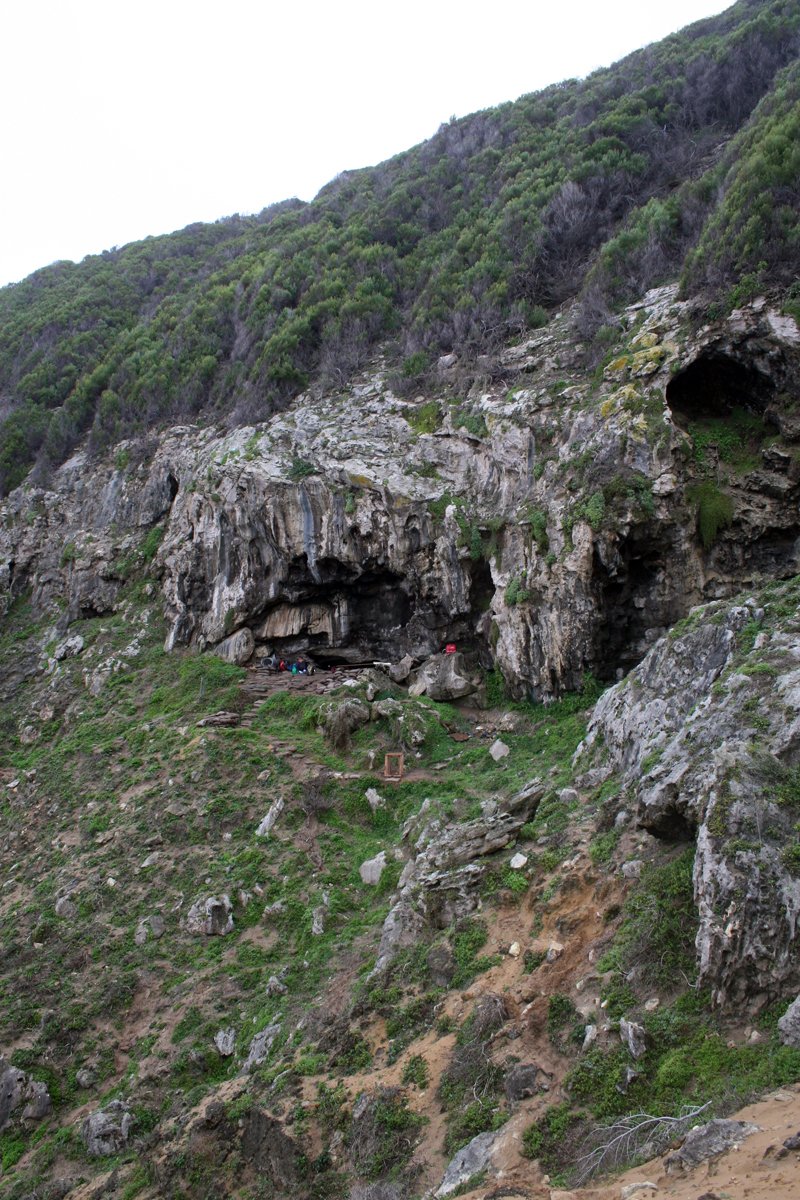Mixing Paint in the Earliest Days- Blombos Cave
How did people make paint in the early days? Well, there's the ochre which I discussed in my last post that gives the color (yellow, orange, red or brown), but how to get it to stick to yourself or the wall? According to finds in the Blombos Cave in South Africa, 100,000 years ago some of our earliest ancestors did it by grinding up the ochre, mixing it with some melted bone marrow fat and adding a dash of urine.
The paint might have been put on skin as an early form of insect repellent, or as a decoration, but we have no way of knowing exactly what the paint's intended purpose was.
 Inside the cave, Christopher Henshilwood of the University of the Witwatersrand in Johannesburg, South Africa, and his team found tools and two abalone shells that were used for mixing and storing the paint. Alongside one of them were quartzite stones used to hammer and grind ochre to a powder, and animal bones used to stir the powder with other materials, which included bone, charcoal, quartz fragments and other stones.
Inside the cave, Christopher Henshilwood of the University of the Witwatersrand in Johannesburg, South Africa, and his team found tools and two abalone shells that were used for mixing and storing the paint. Alongside one of them were quartzite stones used to hammer and grind ochre to a powder, and animal bones used to stir the powder with other materials, which included bone, charcoal, quartz fragments and other stones.http://www.thefridaypost.com/index.php/oldest-artists-workshop-in-the-world-discovered/
The shell pictured above is not only one of the first containers for paint ever found, it is also one of the earliest containers of any kind. We have yet to discover any older containers, and it was tens of thousands of years before anyone was making pottery.
This is the "oldest known drawing by human hands," where you can see red ochre smeared on the wall

This is a piece of ochre, and you can see that someone engraved lines on the side of it.
What do these markings mean? Are the decorative, or do they communicate in some way? This is another question we don't know the answer to. Determining cognitive complexity and function, let alone something's purpose in such ancient days is very hard. There are not a lot of materials that have been preserved down to us. Sub Saharan Africa is also not as well excavated as some other places in the world. Each passing year, however, scientists are discovering more and more hints about how human thinking emerged.
An important aspect remember is that things do not happen in a simple, straight line. One piece of trivia many people have heard of is how Western Civilization forgot the recipe for concrete after the fall of the Roman Empire, and it had to be rediscovered later. This the type of thing that happened all throughout history- there are periods of technological advancement, and then movement in different directions and different places, and sometimes the loss of a technology for a time and its rediscovery later. These simple truths of being human, and our constant changeability as a species over time, adds to the difficulty of being able to present a simple progression of the evolution of our mental complexity.
The early paint workshop and picture are not the only treasures found in Blombos Cave. There were also tools, such as these Bifacial Points

marine sea shell beads

and faunal remains were found in the cave. Faunal remains showed that the early humans had a very varied diet. They would hunt large and small mammals and used a wide variety of plants. Blombos is "considered to represent greater ecological niche adaptation, a more diverse set of subsistence and procurements strategies, adoption of multi-step technology and manufacture of composite tools, stylistic elaboration, increased economic and social organisation and occurrence of symbolically mediated behaviour." (Wikipedia) In other words, the people who lived here:

had complex enough minds to create multi stepped tools, mix multiple ingredients to make something new (paint), knew how to make the most of the environment they lived in, and may have placed symbolic meaning on some of their behavior. These are all traits that make them human, just as we are.
Sources
https://en.wikipedia.org/wiki/Blombos_Cave
Mckay, A. Engraved ochre from a Middle Stone Age context at Klein Kliphuis in the Western Cape of South Africa. 28 August 2007. https://www.academia.edu/235078/Engraved_ochre_from_a_Middle_Stone_Age_context_at_Klein_Kliphuis_in_the_Western_Cape_of_South_Africa Accessed April 8, 2020.

Comments
Post a Comment